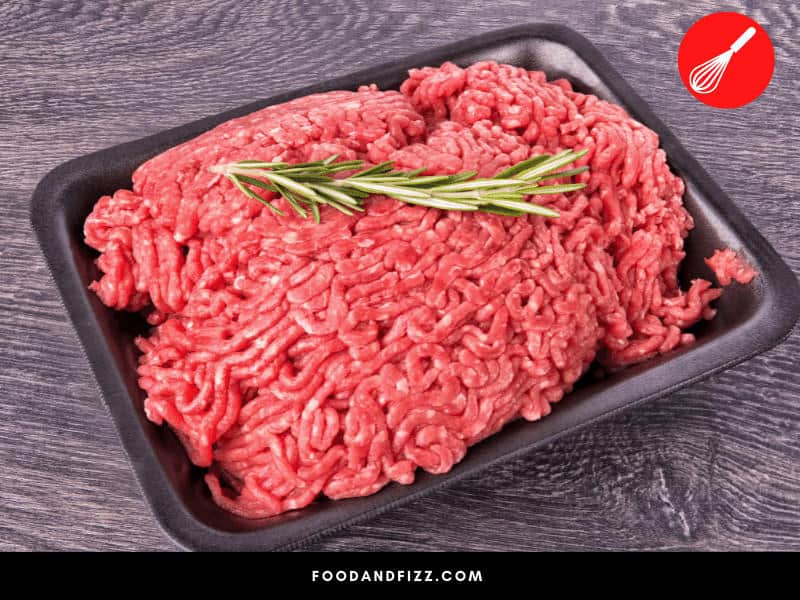Can You Eat Brown Ground Beef? Ground beef is very popular in the USA, as most residents realize. It lends itself well to a variety of affordable, yet delicious recipes. From chili to hamburgers, Americans eat large quantities of ground beef per year.
The amounts of ground beef eaten vary yearly and from decade to decade. Trends and health concerns also affect how much ground beef is eaten. Vegetarianism is in full force now, as is heart health.
In the 1930s, there was much less ground beef eaten than in the 21st Century, which showed an average of 55 to 60 lbs. consumed per person in 2021.
This is tracked by the USDA (United States Department of Agriculture) and linked to cultural traditions such as backyard grilling and sporting events.
Food safety is also a concern of the USDA, and all safety concerns about food are updated regularly on its website. Rising inflation in the US has caused ground beef consumption to diminish somewhat now, although it remains a favorite food.
Many Americans consider ground beef and hot dogs “All American” food and can’t imagine a get-together without these!
Can You Eat Brown Ground Beef?
Brown ground beef is not necessarily a sign that beef has gone bad, but it is a sign that oxygenation has occurred. It is likely safe to eat if only a few areas are brown and it has not permeated most of the meat in the package. However, experts recommend checking the meat thoroughly to ensure that no other signs of food spoilage are present and to check that the meat is still safe to eat.

Can You Safely Eat Brown Ground Beef?
This is a very tricky question but a necessary one. Ground beef loses color quite quickly. In supermarkets, ground beef is covered by plastic or sold in rolls that keep oxygen out. Oxygen turns ground beef from a bright red to a brownish red and then to a grey color.
According to studies done by Ohio State University, it is safe to eat SOME brown ground beef if the color change (and bacteria) have not permeated to the middle of the meat. The Ohio State University does recommend that before eating brown ground beef other signs should be checked to ensure the meat is still safe.

5 Ways to Ensure Brown Ground Beef is Safe to Eat
1. Pull the Meat Apart
If the entire package is brown, even in the middle, oxygen has reached the inside of the meat, and it is wiser, perhaps, not to indulge in it.
Some mild discoloration is not necessarily concerning on the outside as ground beef turns color quickly once released from the wrappings.
2. Look for Any Greyish Coloring
The grey color means the oxygenation and breakdown have advanced more widely and is indeed a concern now as oxygenation breeds bacteria in ground beef. Breakdown now is very obvious.
3. Feel the Ground Beef with Your Hands
Any slimy feeling means that the meat has started to break down and should not be eaten. Who wants to eat slimy food anyway? Any foods, especially meats that are slimy, should be avoided.
4. Smell the Ground Beef by Holding it to Your Nose
Any off-odor indicates the meat is bad and should not be eaten, regardless of color. Ground beef should have a fresh, non-odorous smell to it. Even if not brown or grey in color, an off smell means contamination of some sort.

5. Check the Expiration Dates on the Package
This should be done for all foods, but eating bad meat can be deadly. Salmonella can exist in bad ground beef and can lead to what is called “food poisoning.”
The expiration dates are on packages according to FDA (Food and Drug Administration) regulations and especially with any meat products any spoilage needs to be avoided.
Is it Okay to Eat Grey-looking Sausage at the Market?
It would probably not be a good idea to eat. Sausage and other meat products like meatballs can contain ground beef and pork. Either meat should not be eaten or even purchased if grey looking no matter what kind of “specials” the market is running.
In 2015, there was an uproar in Australia about some processed meats like sausage being cut drastically in costs because they were not fresh, so this happens not just in the USA.
There is a myth that sausage, meatballs, and other types of ground beef and pork are not worth regulating since these are made from offal, which is bits and pieces of the entire cow and pig, but this is not true, and all odd colored meats should not be purchased.

Don’t Stores Have a Duty to Ensure Correct Expiration Dates?
Yes, they do, but many occurrences or mistakes do happen, unfortunately. Stores need to make money and can offer tremendous savings on ground beef that is set to expire or has expired.
While regulations exist, there are no real consequences if the store explicitly states that the ground beef must be “Sold By” or “Used By” on a certain date. This is a legal loophole, so it is on you to read the sides of each package you purchase.
There are usually only warning letters sent first by the Food and Drug Administration (FDA) to offending stores once reports of illness come in.
Continued non-compliance can result in criminal prosecution, but only if food is sold that makes others ill and in large quantities. Individuals can contact an attorney for remedies.
Conclusion To Can You Eat Brown Ground Beef
You can, but only if the outside is only slightly brown and the expiration date is not expired.
Your eyes, hands, and nose will tell you when brown ground beef has become unsafe, and you need to inspect it thoroughly and pay attention to the expiration dates.
Enjoy ground beef but do so cautiously and follow all safe cooking guidelines, such as not eating it raw and cooking it to a safe temperature.
Most calls to the USDA (United States Department of Agriculture) about bad food are for ground beef and poultry so shop and cook smartly using their guidelines!

Frequently Asked Questions To Can You Eat Brown Ground Beef
How Can I Stop My Ground Beef From Turning Brown?
The best way is to freeze it when you bring it home from the market. When you defrost it cook it within a day or two. This can be done with most meats and fish without compromising flavor.
My Ground Beef Only Has a Few Brown Spots. Can I Eat It?
Most likely, you can if you just purchased it or defrosted it. Ground beef is made from many parts of a cow, so there can be bright red coloration with a few brown spots in it, yet it’s still safe.
When I Leave My Ground Beef Frozen for A Long Time, It Looks Bad. Is it?
This is likely a freezer burn. It is not spoiled but probably has lost its good natural flavor. Freezer-burned meats or other foods are not dangerous but do not have the same quality as foods prepared within under a month.

